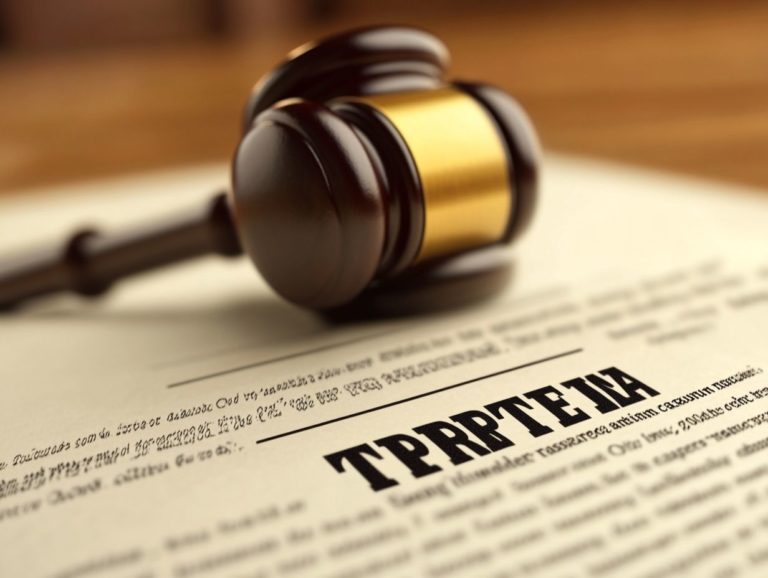The Process of Trademark Opposition Explained
Trademark opposition is a vital aspect of intellectual property that safeguards your brand identity. It arises when a party challenges the registration of a trademark, claiming it may lead to confusion or harm to their established brand.
Grasping this process is crucial for you, whether you are a business owner, a legal professional, or anyone engaged in branding. It can significantly affect the viability of a trademark.
This article will serve as your comprehensive guide through trademark opposition, delving into its significance, the filing process, the key factors considered, and the potential outcomes. Together, we will unpack each element to empower you in navigating this intricate landscape.
Contents
Key Takeaways:

- Trademark opposition is a legal proceeding to challenge the registration of a trademark by another party.
- The process involves filing a Notice of Opposition, responding to the applicant’s response, and presenting evidence and arguments from both parties.
- In trademark opposition, factors such as similarity of marks, likelihood of confusion, and proof of prior use and distinctiveness are considered.
- Possible outcomes include settlement, appeal, or cancellation of the trademark.
Understanding Trademark Opposition
Trademark opposition is a crucial legal process within the United States Patent and Trademark Office (USPTO). When you file a Notice of Opposition against a trademark application, you’re asserting that the registration of that mark would infringe upon your existing trademark rights, lead to consumer confusion, or result in other legal conflicts. For those navigating this process, understanding trademark assignment key steps is also essential.
This procedure typically takes place within a designated opposition period and includes various legal proceedings with the Trademark Trial and Appeal Board (TTAB). Given the complexities involved, it s vital for trademark owners like you to navigate these waters with the expertise of a qualified trademark attorney.
What is Trademark Opposition?
Trademark opposition is a formal legal process you can initiate if you believe that a pending trademark application could infringe on your trademark rights or lead to consumer confusion. This process acts as a safeguard for established marks, allowing you to protect your intellectual property from potential infringements.
When a trademark is filed, you, as an interested party, can challenge its registration by submitting a Notice of Opposition to the appropriate trademark office, usually within a specific timeframe often 30 days. This notice should clearly outline your reasons for opposing the application and the legal grounds upon which you’re relying.
By presenting these objections, you underscore the potential for confusion in the marketplace, ensuring that your brand remains distinct and protected from encroachments that could jeopardize your reputation or create unnecessary market confusion.
Importance of Trademark Opposition
The significance of trademark opposition lies in its crucial function of protecting trademark rights. It prevents the registration of marks that could confuse consumers or tarnish the reputation of an existing brand. This process upholds the integrity of the marketplace, allowing consumers to confidently identify the source of goods and services.
Picture this: a new brand enters the scene with a name alarmingly similar to that of a well-established company. The likelihood of consumer confusion skyrockets, leading to a breakdown of trust and loyalty.
In this intricate landscape, trademark attorneys are your allies. They expertly maneuver through the complexities of opposition proceedings to defend established trademarks. They don t just present compelling arguments; they conduct meticulous investigations to ensure brands can effectively assert their rights against potentially infringing applications.
The Process of Trademark Opposition
The process of trademark opposition unfolds through several carefully defined steps, commencing once a trademark application is published by the USPTO. It begins with you filing a Notice of Opposition, which articulates the grounds for your opposition and the legal basis for your claims against the trademark applicant. For a deeper insight, consider reviewing understanding the trademark review process.
This initiates a series of legal proceedings before the Trademark Trial and Appeal Board (TTAB), where both you and the applicant will have the opportunity to present your evidence and arguments. If you face trademark issues, seek legal help to navigate this complex landscape effectively.
Filing a Notice of Opposition

Filing a Notice of Opposition is your first formal step in the trademark opposition process. It allows you to contest a trademark application that conflicts with your existing trademark rights or could confuse consumers.
This critical action requires careful writing according to the guidelines set by the United States Patent and Trademark Office (USPTO). Make sure you have valid reasons for your claims, which might include prior use of a similar mark or evidence showing that the application could mislead consumers.
Team up with a trademark attorney now! Their expertise will be your secret weapon in this crucial phase. They can provide invaluable guidance on legal nuances, deadlines, and necessary documentation to boost your chances of success.
Response from the Applicant
Once a Notice of Opposition is filed, you must respond within a specified timeframe, addressing the claims made against your trademark application. This moment can lead to further legal proceedings if not handled properly.
During this phase, gather all relevant documentation and evidence that supports your claim to trademark rights. Legal counsel specializing in intellectual property can offer insights and strategies for navigating the opposition process.
Consider conducting a thorough search for prior registrations to strengthen your position. Prepare a comprehensive statement that refutes the grounds for opposition while highlighting the unique aspects of your mark. This could be highly beneficial.
You can also explore settlement negotiations as a way to avoid lengthy litigation. Crafting a strong response is vital for safeguarding your trademark rights.
Evidence and Arguments from Both Parties
In a trademark opposition, both parties present evidence and arguments to support their positions. This often includes proof of prior use, assessing the likelihood of confusion, and considering other relevant factors for the TTAB.
As the applicant, submit a range of documentation like advertisements, customer testimonials, or market surveys to showcase your brand s distinctiveness and prove there s no confusion. The opposing party may present evidence like affidavits or registrations that highlight similarities, which could influence the TTAB s decision.
Thorough preparation is essential in these proceedings. Trademark attorneys know that the strength of your case relies heavily on solid evidence. They gather and analyze necessary documents to craft compelling arguments, ensuring your position is robust and well-supported before any hearings take place.
Factors Considered in Trademark Opposition
In trademark opposition cases, several critical factors come into play. These include the similarity of the marks, the likelihood of consumer confusion, proof of prior use, and the distinctiveness of the trademarks involved.
Each of these elements plays a pivotal role in shaping the outcome of legal proceedings, influencing how the case unfolds and ultimately concludes.
Similarity of Marks
The similarity of marks is a pivotal consideration in trademark opposition cases. Greater resemblance often amplifies the risk of consumer confusion and potential infringement on trademark rights.
When evaluating this similarity, consider various criteria, including visual, phonetic, and conceptual aspects of the trademarks involved. Analyzing these elements is crucial in determining whether consumers might inadvertently associate one mark with another, thereby diluting the distinctiveness vital for brand recognition.
The consequences of consumer confusion are significant; they jeopardize the economic interests of trademark owners and risk misleading consumers into making ill-informed decisions.
Ultimately, maintaining a clear distinction between competing marks is essential for fostering a trustworthy marketplace and safeguarding brand integrity.
Likelihood of Confusion

The likelihood of confusion refers to the probability that you might mistakenly believe two trademarks are related or come from the same source. This concept is central to trademark opposition analysis.
It plays a vital role in determining the outcome of opposition cases. In these cases, parties argue the potential for consumer misunderstanding. The legal standards for assessing this likelihood often rely on the Lanham Act, a federal law governing trademarks, and various case law guidelines.
Courts evaluate factors such as:
- the similarity of the marks,
- the nature of the goods or services offered,
- the channels of trade through which they are marketed.
Notable cases, like Polaroid Corp. v. Polarad Electronics Corp., highlight the intricacies involved in these assessments. This underscores the importance of context. A thorough analysis of these elements can greatly influence your opposition claim s success.
Proof of Prior Use and Distinctiveness
Proof of prior use is essential in trademark opposition. It establishes your rights to the trademark in question.
Distinctiveness can significantly influence the strength of your opposition case. These two factors are critical in determining the outcome of disputes.
When you can demonstrate continuous and prior use of a trademark, it asserts your ownership and reinforces your market presence. The distinctiveness of your mark whether inherently distinctive or acquired through extensive use holds considerable weight.
To substantiate claims of distinctiveness, present various forms of evidence. This could include consumer surveys, advertising expenditures, and examples of media coverage. This combination of proof helps you build a compelling argument, significantly influencing the resolution of trademark disputes.
Possible Outcomes of Trademark Opposition
The possible outcomes of trademark opposition can vary considerably. You might find yourself in a situation that leads to a settlement, or you could appeal to the Trademark Trial and Appeal Board (TTAB).
In some cases, the result could even be the cancellation of the trademark application. This all hinges on the evidence and arguments you present during the legal proceedings.
Settlement
Settlement in trademark opposition cases provides a valuable opportunity to resolve disputes amicably. Often, this is through agreements that safeguard your trademark rights without delving deeper into legal battles.
These settlements can vary significantly in their terms, frequently including provisions like co-existence agreements or licensing arrangements.
By opting for this resolution method, you save precious time and legal fees. You also steer clear of the uncertainties that come with court outcomes.
Carefully reviewing the terms is essential to ensure they boost your brand s future. Engaging in settlements can nurture a more collaborative relationship, potentially paving the way for future business opportunities.
Appeal to the Trademark Trial and Appeal Board
If you are dissatisfied with the outcome of a trademark opposition or wish to challenge a decision made by the TTAB, you have the option to file an appeal. This opens the door for further legal proceedings to reassess your case.
This process typically involves submitting a notice of appeal to the U.S. Court of Appeals for the Federal Circuit or, in some situations, to a district court. Once you initiate the appeal, it s essential to present compelling legal arguments and relevant evidence that support your position.
Highlight any potential errors in the original decision. Strategies such as rigorous legal research and incorporating expert testimonies can significantly strengthen your case.
Don t overlook the deadlines and procedural requirements, as these factors can greatly influence the outcome and your trademark rights.
Cancellation of the Trademark

If a trademark opposition is successful, the trademark may be canceled. This results in the removal of the contested trademark from the registry, safeguarding the trademark rights of the opposing party.
This outcome can have big effects not just for those directly involved but also for the broader marketplace dynamics. When a trademark faces cancellation, it removes potential confusion for consumers regarding brand identity, thereby preserving the integrity of established trademarks.
This cancellation reminds other businesses about the importance of strong trademark protections, which can deter future infringements.
The market may experience shifts as competitors scramble to fill the now-available space, influencing consumer choices and brand strategies in the process.
In this scenario, the legal precedents established by successful opposition cases can significantly bolster the enforcement of trademark rights. This promotes a more transparent and equitable business environment.
Frequently Asked Questions
Here are some common questions about trademark opposition.
What is trademark opposition?
Trademark opposition is a legal process in which an individual or company can challenge the registration of a trademark by another party.
Who can file a trademark opposition?
Any individual or company that believes they will be harmed by the registration of a trademark can file a trademark opposition.
What are the grounds for filing a trademark opposition?
There are several grounds for filing a trademark opposition, including prior use of the trademark, likelihood of confusion, and lack of distinctiveness.
How do I file a trademark opposition?
To file a trademark opposition, you must submit a written notice to the appropriate trademark office within a specific time frame, typically 30 days after the publication of the trademark.
What happens after a trademark opposition is filed?
After a trademark opposition is filed, both parties will have the opportunity to present evidence and arguments to support their case. A decision will then be made by the trademark office or a court.
What are the potential outcomes of a trademark opposition?
The potential outcomes of a trademark opposition include the trademark being rejected, the trademark being allowed with certain limitations or conditions, or the trademark being granted in full. If the opposition is successful, the trademark registration may be canceled or amended.
If you need help with trademark opposition, don t hesitate to reach out to a legal expert today!






